Overview of 90s Fashion
In the overview of 90s fashion, supermodels became the stars of the fashion world. Naomi Campbell, Cindy Crawford, and Kate Moss were everywhere, influencing how young people dressed, walked, and even talked.
Introduction To 90s Fashion, Including Popular Themes And Influences
The 1990s were a transformative decade for fashion, marked by a shift from the opulence of the 1980s to a more minimalist and diverse aesthetic. Economic factors, cultural movements, and technological advancements all played roles in shaping the trends that defined this era. From the rise of supermodels to the grunge revolution, 90s fashion embraced both glamour and rebellion, setting the stage for the eclectic styles we see today.
Influence of Supermodels and Celebrity Style
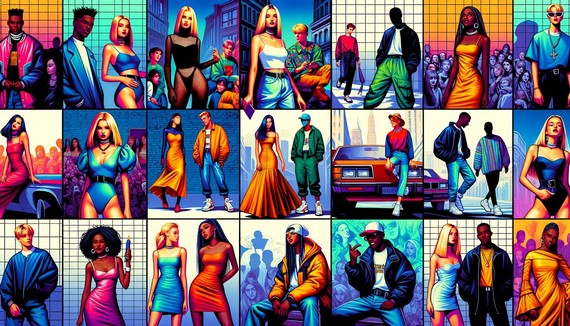
90s fashion trends collage
In the overview of 90s fashion the early 1990s saw the meteoric rise of supermodels, who became household names and fashion icons in their own right. The “Big Four” – Linda Evangelista, Cindy Crawford, Naomi Campbell, and Christy Turlington – dominated runways and magazine covers, embodying the powerful, liberated woman of the decade.
“Why are these girls so famous? Why are they personalities in their own right? Why are they known from one side of the globe to the other?”
These questions, posed by Vicki Woods in Vogue’s July 1991 issue, encapsulated the phenomenon of the supermodel. Their influence extended beyond fashion, as they became cultural touchstones and savvy businesswomen.
By mid-decade, a new wave of models emerged, including Kate Moss, Shalom Harlow, and Amber Valletta. This group represented a shift towards a more waif-like, vulnerable aesthetic that aligned with the emerging grunge movement.
Celebrities also played a crucial role in shaping 90s fashion trends. From the red carpet to music videos, stars like Madonna, Jennifer Aniston, and Sarah Jessica Parker influenced what people wore on the streets.
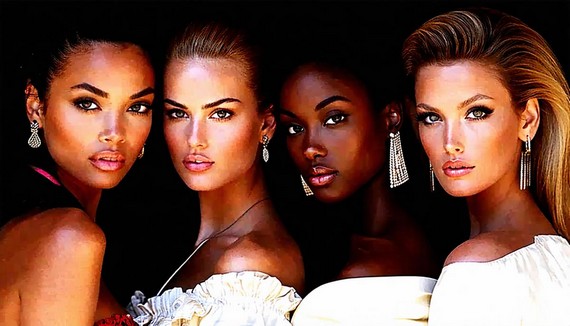
Four 90s supermodels posing together on a Vogue magazine cover, embodying the glamour and influence of the era
Grunge and Minimalist Aesthetics
The grunge movement, born in Seattle’s music scene, had a profound impact on 90s fashion. Characterized by flannel shirts, ripped jeans, and a deliberate “anti-fashion” stance, grunge represented a rebellion against the excesses of the previous decade.
- Flannel shirts
- Vintage t-shirts
- Baggy, distressed jeans
- Combat boots or sneakers
- Unkempt hair
Designer Marc Jacobs famously brought grunge to high fashion with his controversial Spring/Summer 1993 collection for Perry Ellis, which ultimately led to his dismissal but cemented his status as a visionary.
In contrast to grunge’s deliberate dishevelment, minimalism emerged as a dominant force in 90s fashion. Designers like Calvin Klein, Jil Sander, and Helmut Lang championed clean lines, neutral colors, and impeccable tailoring. The slip dress, often worn over a t-shirt, became an iconic piece of the minimalist movement.
Key elements of 90s minimalism:
- Monochromatic color palettes
- Simple silhouettes
- High-quality fabrics
- Lack of embellishment
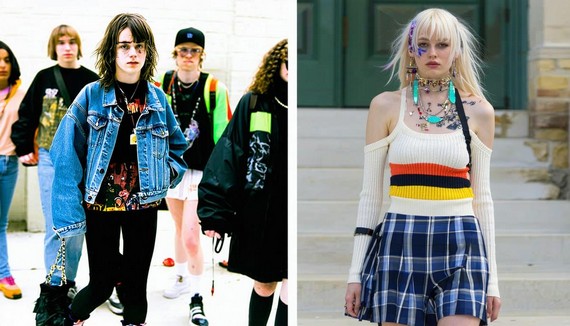
A split image contrasting 90s grunge fashion with minimalist style, showing the diverse trends of the decade
The Role of Pop Culture and Music Influences
Overall music continued to be a driving force in fashion throughout the 90s. Hip-hop culture had a significant impact, popularizing oversized silhouettes, sportswear brands, and bold accessories. Artists like TLC and Aaliyah became style icons, influencing young women to embrace crop tops, baggy pants, and athletic-inspired looks.
The Britpop scene in the UK brought mod-inspired fashion back into the spotlight, with bands like Oasis and Blur sporting retro looks that included parkas, polo shirts, and desert boots.
Television also played a crucial role in disseminating fashion trends. Shows like “Friends” and “Beverly Hills, 90210” showcased the latest styles, making characters like Rachel Green (Jennifer Aniston) and Brenda Walsh (Shannen Doherty) unexpected fashion influencers.
The Rise of Designer Labels and Diffusion Lines
An overview of 90s fashion in the 90s saw a boom in the business of fashion, with luxury brands expanding their reach through diffusion lines and extensive licensing deals. Examples include:
- DKNY by Donna Karan
- D&G by Dolce & Gabbana
- Versus by Versace
- Emporio Armani by Giorgio Armani
These more affordable lines allowed a broader audience to access designer fashion, contributing to the democratization of style that characterized the decade.
A group of pop culture icons wearing influential fashion styles from music, TV, and designer labels
The 1990s left an indelible mark on fashion history, introducing trends and concepts that continue to influence designers and consumers today. From the glamour of supermodels to the raw edge of grunge, the decade’s diverse styles reflected a world in transition, embracing both tradition and rebellion. As we look back on 90s fashion, we see not just a collection of trends, but a cultural snapshot of a transformative era.
References:
- 1. Woods V. Supermodels: The Sequel. Vogue. 1996. 2. Menkes S. Marc Jacobs for Perry Ellis Review. Vogue. 1993. 3. Hennessey K. Fashion: The Ultimate Book of Costume and Style. Dorling Kindersley; 2012. 4. de la Haye A, Tucker A. Costume and Fashion: A Concise History. Thames & Hudson; 2010.
Overview of 90s Fashion – Supermodels and Cultural Impact

Fashion trends collage
Naomi Campbell broke barriers as the first black model fronting major fashion magazines. Her presence on the catwalk was captivating, leading to a shift in how diversity was perceived in fashion.
Cindy Crawford, with her trademark mole, became a household name. Her Pepsi commercials blended allure with everyday appeal, showcasing the fusion of consumerism and celebrity power.
Kate Moss ushered in the “heroin chic” look, a departure from the voluptuous standards set by her predecessors. Her style resonated with a generation seeking authenticity and nonchalance.
These supermodels reshaped perceptions of femininity and allure. Their influence extended beyond fashion into music, television, and public consciousness. The 1990s supermodel phenomenon was not just a stylistic shift but a cultural movement that continues to impact fashion today.
Overview Of 90s Fashion – Key Fashion Trends
An overview of 90s fashion saw an eclectic mix of fashion trends. Grunge, originating from Seattle’s music scene, made its mark with flannel shirts, ripped jeans, and Doc Martens. This style embraced a comfort-first, authentic approach to self-expression.
Minimalism also took center stage, championed by designers like Calvin Klein and Helmut Lang. Slip dresses became a symbol of this trend, offering a stark contrast to the exuberance of the ’80s with their clean lines and understated elegance.
The decade also revived styles from previous eras, particularly the ’70s. Embroidered jeans and suede fringed vests made their way into mainstream wardrobes, blending retro charm with modern sensibilities.
Whether embracing the raw vibe of grunge or the polished grace of minimalism, the overview of the ’90s redefined fashion rules, leaving a lasting impact on style.
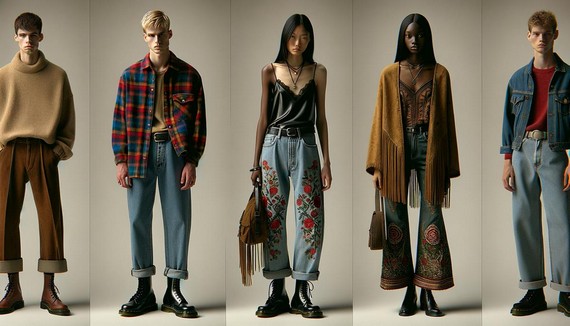
Models showcasing key 90s fashion trends including grumge., minimalism and 70s revival styles.
Cultural and Technological Influences
An overview of 90s fashion saw the 1990s saw fashion intersect with cultural and technological developments in new ways. Hip-hop emerged as a leading cultural force, influencing global fashion with oversized silhouettes and bold logos. Artists like Tupac Shakur and The Notorious B.I.G. set trends with baggy jeans, oversized jerseys, and gold chain accessories. Brands like Tommy Hilfiger and Karl Kani tapped into this cultural renaissance, embodying the spirit of hip-hop in their designs.
Television shows also played a pivotal role in shaping fashion norms. ‘Friends’ became a style inspiration, with Jennifer Aniston’s character Rachel Green influencing women’s wardrobes more than many high-fashion runways.
The rise of digital technologies marked a new era for the fashion industry. The internet allowed fashion shows to reach global audiences, enabling trends to spread at unprecedented speeds. This digital revolution laid the foundation for e-commerce and online fashion, democratizing access to style information and trends.
An overview of these cultural and technological influences in 90s fashion converged to create a new fashion dialogue, setting the stage for innovation and crafting a collective fashion consciousness that would persist into the future.
References:
- McRobbie A. Second-Hand Dresses and the Role of the Ragmarket. In: Zoot Suits and Second-Hand Dresses. Palgrave Macmillan; 1989.
- Hennessey K. Fashion: The Ultimate Book of Costume and Style. Dorling Kindersley; 2012.
- de la Haye A, Tucker A. Costume and Fashion: A Concise History. Thames & Hudson; 2019.
overview of 90s fashion Influences
The 90s were a time of distinct style shifts, where fashion trends mirrored the cultural and societal changes of the era. From grunge to minimalism, each trend offered a reflection of personal expression and collective identity. The overview of 90s fashion in this period was marked by an intriguing blend of influences that shaped wardrobes worldwide.
Popular 90s Fashion Trends
Grunge fashion made waves in the early 90s, embodying a nonchalant vibe with a rebellious edge. Oversized flannel shirts layered over vintage band tees, paired with ripped jeans and rugged boots—often inspired by the likes of Kurt Cobain and Pearl Jam. This laid-back look was about more than just clothes; it was an attitude, a shrug against the flashy ’80s, a nod to authenticity and individual expression.
Minimalism offered a counterpoint in the overview of 90s fashion, stripping back the excesses of the previous decade. The ’90s saw the rise of designers like Calvin Klein and Jil Sander, who championed the ‘less is more’ ethos. Think sleek slip dresses, clean lines, and neutral tones, with a hint of understated glamour. Kate Moss emerged as a poster child for this movement, her look embodying the era’s sophisticated yet raw edge.
Streetwear also found its footing, bringing together elements of hip-hop and skate culture. Baggy jeans, oversized tees, and chunky sneakers became sartorial staples for the cool crowd. Labels like Tommy Hilfiger and FUBU thrived, capitalizing on a fashion revolution led by the likes of Will Smith and Aaliyah. The integration of streetwear into mainstream fashion spoke to a growing cultural blend, celebrating diversity through style.
In our overview pop culture icons of the 90s era left their mark. Sitcoms like “Friends” introduced us to the iconic ‘Rachel Cut,’ while “The Fresh Prince of Bel-Air” showcased playful preppy styles. Films like “Clueless” and “The Matrix” heavily influenced wardrobe choices, from plaid skirts and knee socks to sleek leather jackets.
In the overview of 90s fashion the 90s were a mosaic of subcultures converging and reimagining the fashion map. The vibrant rave scene brought neon colours and psychedelic patterns, while punk elements resurfaced through leather and spikes, fostering a dynamic visual dialogue. Each trend reflected broader societal shifts—embracing individualism while adapting to a rapidly globalising world.
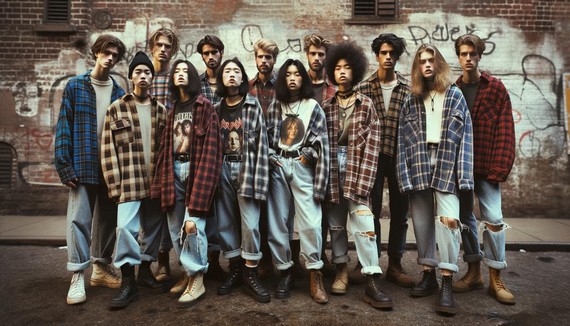
A group of young people wearing classic 90s grunge fashion, including oversized flannel shirts, vintage band tees, ripped jeans, and rugged boots
Role of Supermodels and Celebrity Influence
In the overview of 90s fashion, supermodels emerged as powerful figures, redefining the fashion industry. Cindy Crawford, Naomi Campbell, and Kate Moss weren’t just faces on magazine covers; they were trendsetters who blazed trails in fashion circles and beyond. Their presence was captivating, commanding runways and advertising campaigns with an allure that transcended the traditional model role. They became household names, ingrained in the cultural zeitgeist of the decade.
Cindy Crawford became the embodiment of all-American glamour, her famous mole as recognisable as the Versace dresses she flaunted. Naomi Campbell broke through barriers with her fierce walk and timeless beauty. Kate Moss’s waifish figure and enigmatic presence epitomised the grunge and minimalist trends that swept the decade. Her influence helped cement ‘heroin chic’ as a pivotal movement, reflecting a shift towards an edgier, raw aesthetic.
Beyond the runways in the overview of 90s fashion, celebrities and musicians also played pivotal roles as fashion ambassadors. Madonna’s daring fashion choices constantly pushed boundaries, encouraging fans to express themselves fearlessly. Aaliyah’s penchant for baggy trousers and crop tops married streetwear with femininity. The Spice Girls brought British flair to the forefront with their platform trainers and eclectic outfits, celebrating individuality.
Television and film stars weren’t far behind in the style stakes. Will Smith’s laid-back wardrobe as the “Fresh Prince” made urban styles more accessible and desired. Characters like Cher in “Clueless,” with her enviable plaid ensembles, dictated fashion, ensuring trends from the screen translated into real life.
The relationship between fashion and fame in the ’90s signified a broader cultural shift, illustrating that style was as much about who wore it as the clothes themselves. Supermodels and celebrities became the conduits through which trends travelled, captivating global audiences with their distinct, influential style stories.
Ultimately, in the overview of 90s fashion the 90s left an indelible mark on fashion, with its eclectic mix of styles and cultural influences. It was a decade that celebrated individuality while embracing change, setting the stage for future fashion revolutions.
- Hennessey K. Fashion: The Ultimate Book of Costume and Style. London: Dorling Kindersley; 2012.
- Laver J, de la Haye A, Tucker A. Costume and Fashion: A Concise History. 5th ed. London: Thames & Hudson; 2012.
- Woods V. The Phenomenon of the Supermodel. Vogue. 1991;181(7):190-195.
- Menkes S. Grunge: A Success Story. Vogue. 1993;183(1):96-97.
- Poneman J. Grunge & Glory. Vogue. 1992;182(12):254-263.


